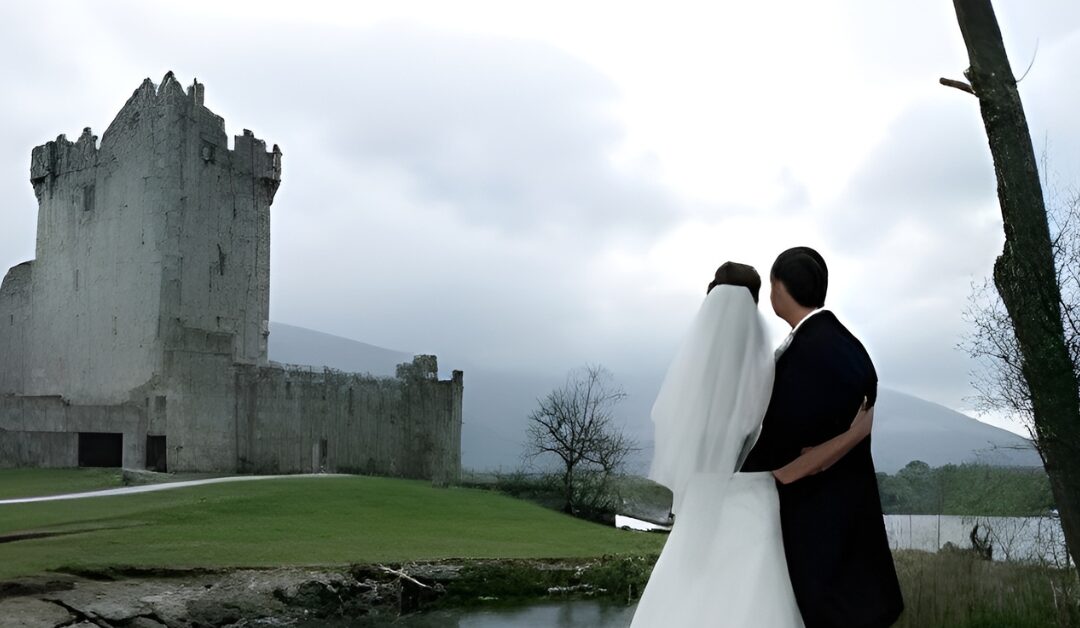An article by Joice Gibson, Chorale Board member & our resident musicologist
“Mairi’s Wedding” is a joyful and iconic Scottish folk-like song. It was originally written in Scottish Gaelic by John Roderick Bannerman in 1934 to honor Mary Connell MacNiven, who won the gold medal for her performance at the prestigious singing competition at the National Mòd (pronounced “mode”)—a festival celebrating Gaelic song, literature, and culture.
The Gaelic version is titled “Màiri Bhàn” (Blonde or Fair Mary). The English version, widely known today as “Mairi’s Wedding” or “The Lewis Bridal Song,” was adapted by Sir Hugh Roberton in 1936 and became a celebration of a wedding, full of rural imagery and cultural pride. However, the English lyrics barely resemble the original Gaelic. Robertson presented a copy of the song to MacNiven and it reportedly became one of her prized possessions. Mary MacNiven wed in 1940 and became Mary Campbell (which is how you can find her recordings), but we don’t know whether the song was featured at her wedding ceremony. She died in 1997 at the age of 91 (singing helps keep you young!). In 1959, James B. Cosh devised a Scottish country dance, a 40-bar reel, which was one featured at our recent ceilidh (KAY-lee) and likely the dance referred to in the chorus. The Scottish snap (short-long rhythmic gesture on the beat) lends the melody a distinctive highland lilt.
There are several terms in the verses that are generally unfamiliar to American singers and listeners. Starting with the first verse, there is myrtle, a green plant with tiny flowers that grows in bogs whose leaves can be used to make tea, flavorings, insect repellant, essential oil (for sensitive skin and acne), and medicine (a theme that continues below) – and even schnaps. Bracken is a type of large, coarse, weedy fern that grows in Scotland (a pesky invasive species) or more generally a patch of undergrowth. (The word also means “speckled” or “spotted” in Irish.) A shieling is a hut or shelter used seasonally by shepherds or cattle herders when moving livestock to upland pastures in the summer.
The second verse is all about well-wishes for Mairi in her married life. Herring, of course, is a type of fish whose mention in the song suggests either that the community is in a coastal region or they were acquired seasonally and salted or smoked for preservation. Peat, formed in those same bogs where myrtle grows, is harvested for fuel to heat the home and in the song is gathered in a creel. People who enjoy fishing may be familiar with the term “creel,” but there are many types of creel. For Mairi, such a woven basket for transporting goods, in this case peat, could refer to either one carried by hand or a large one carried on the back, the latter of which was often the case for women and children. Bonny bairns are lovely, happy, and healthy (bonny) babies (bairns), traditionally a wish for newlyweds.
Verse three praises Mairi’s many pleasing attributes, reflecting how beloved Mairi is in the rural community. One word that is likely unfamiliar is rowans, a reference to rowan trees (also known as mountain ash) that typically grow in rocky or upland areas. In the song, the tree’s clusters of red berries that bloom in the fall are compared to Mairi’s rosy red cheeks. But rowans also have additional significance in Scottish culture, as does a previously mentioned term.
The use of “bracken” in the song has both pagan and Christian meanings and functions. In Celtic mythology, bracken was associated with protection, divination, and renewal, believed to possess magical properties and ward off evil spirits. For instance, witches feared it when it was cut as it formed the Greek letter “X,” a symbol of Christ. In Ireland, it was known as the fern of God because it was said that when the stem is cut at three points, each point displays a letter which together spell “God.” Those uses also align it with the rowan tree mentioned in the third verse, whose wood was also used for magical or ceremonial purposes (such as Samhain/”Halloween” and Beltane/May 1st) for similar reasons.
There’s another cultural connection. “Bracken” is often used as a gender-neutral given name that has become increasingly popular in more recent years, likely due to its association with nature. Or perhaps for its association with Saint Breacain, a an Irish 6th-century Christian saint known as a healer.
All in all, “Mairi’s Wedding” makes it clear that Mairi is beloved by her rural highland community and her wedding is a welcome cause to gather and joyfully celebrate together. What a fitting tribute to Mary Campbell (née MacNiven), who continues to be admired as a model for Gaelic singing by the Scottish folk/traditional community.
—
About Joice W. Gibson, PhD – For over two decades at MSU Denver, I taught graduating seniors who were preparing for their senior recitals a class that was all about writing program notes for their recitals (vocal, instrumental, and composition). In addition to the fun info that I provided here, the vocal students and I also dived into the music features and how they worked together with the lyrics. They often discovered things that they hadn’t picked up when preparing to sing the songs (in various languages), which ultimately enhanced their performance of their songs – in addition to learning how to write program notes for their future careers.
To experience the musical joy of “Mairi’s Wedding” and more Celtic music with us, please visit our Tickets page to purchase your tickets for Sunday’s concert!
“The Call of the Highlands” – Sunday, Oct. 19 at 3pm at Longmont HS Auditorium
Special guests: The Denver & District Pipe Band and Highland & Irish Dancers!
##
The Longmont Chorale is a nonprofit Longmont choral group, an SATB choir which performs four major concerts in Longmont each season. Concert tickets and information are both available at LongmontChorale.org/Tickets.
Like this post? Share it with a friend, using the social media bar on the side of this page (desktop) or below (mobile).


